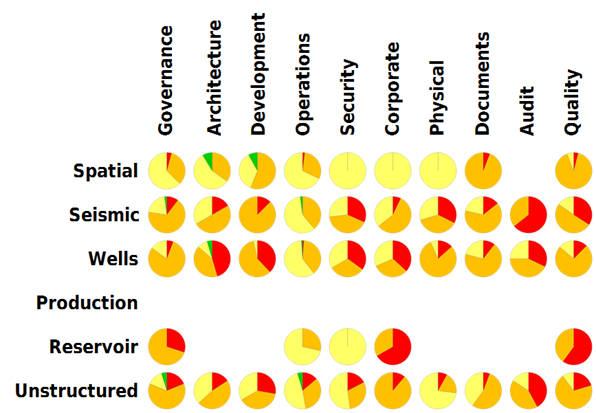
| Home | FAQs | Book Contents | Updates & News | Downloads |

It is well known that as ideas flow through brains, books and presentations they are continually being grasped, refined and re-expressed in slightly different forms. The concept of "Data Management Maturity" is a fantastic illustration, these days any data handling consultant in the oil industry that wants to be taken seriously has to be familiar with the underlying theory. I am assuming you already understand the various levels, if you are unfamiliar then your local expert will be able to point you towards a short introduction (or you can read the paper that I mention later). Most "mature" consultants don't just have a few slides that explain the concept but they also have specialised tools to apply it. In Schlumberger we certainly see this as an essential part of our assessment methodology and it is clear that many others do too, to pick just a single example Westheimer Consultants' BIM5 toolkit "quantifies data management capability levels".
My understanding is that the concept originated with Watts Humphrey's work on the "Capability Maturity Model", a tool for assessing the software development processes employed by US government contractors in the late 1980s. The Software Engineering Institute of Carnegie Mellon University realised that as the "Data Management Maturity Model" this could be extended to measuring business activities. In the 1990s research tailored this concept to defining metrics for the management of sub-surface data. By the time I became aware of the idea it had been long established (at least within Schlumberger). It became clear that a simple, single value, estimate of maturity was not quite sufficient, so we devised ways to extend it with measurements of "information landscape complexity". In 2008 Jess Kozman and I published an explanation of how this could be applied and why it worked so well (that original paper can be downloaded from dm4ep.com).

In his book "Outliers" Malcolm Gladwell popularised the "10,000 hour rule", a guideline that emerged from studies by Anders Ericsson into expertise in acting, music, sports and medicine. The claim is that in all these disparate fields it takes years of "deliberate practice" to become a "true expert". I know a number of people who I would consider to be "true experts" in the concept of maturity. When I roughly estimate the amount of time they each have each spent working with the idea every one of them has clocked up at least 5,000 hours. I think the way we apply the idea of "Maturity" has reached the level of maturity where the results are at least predictive. Also, for me, introducing the concept (again) is not necessary.
Article 16 |
Articles |
RSS Feed |
Updates |
Intro |
Book Contents |
All Figures |
Refs |
Downloads |
Links |
Purchase |
Contact Us |
Article 18 |